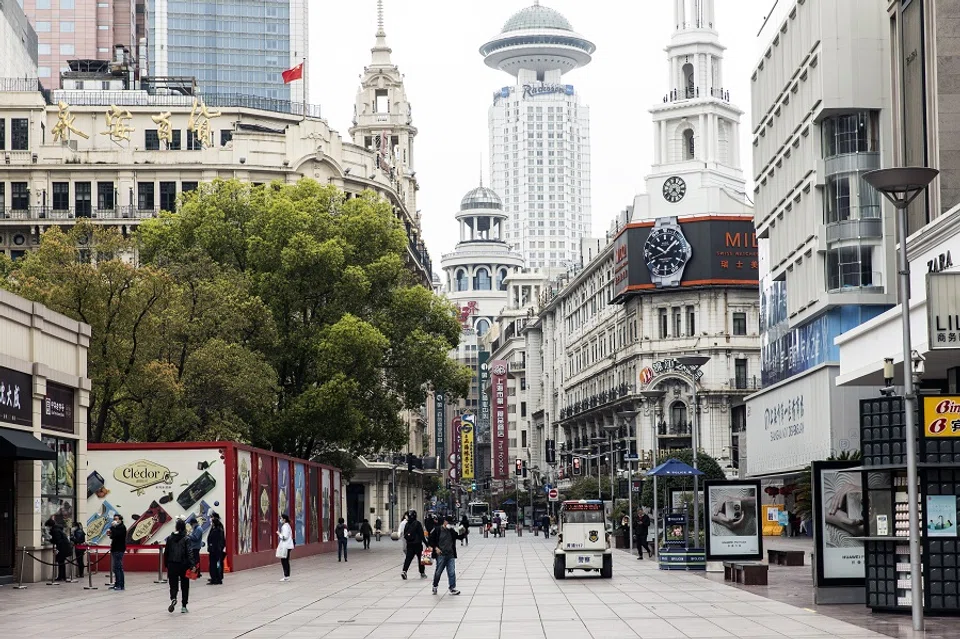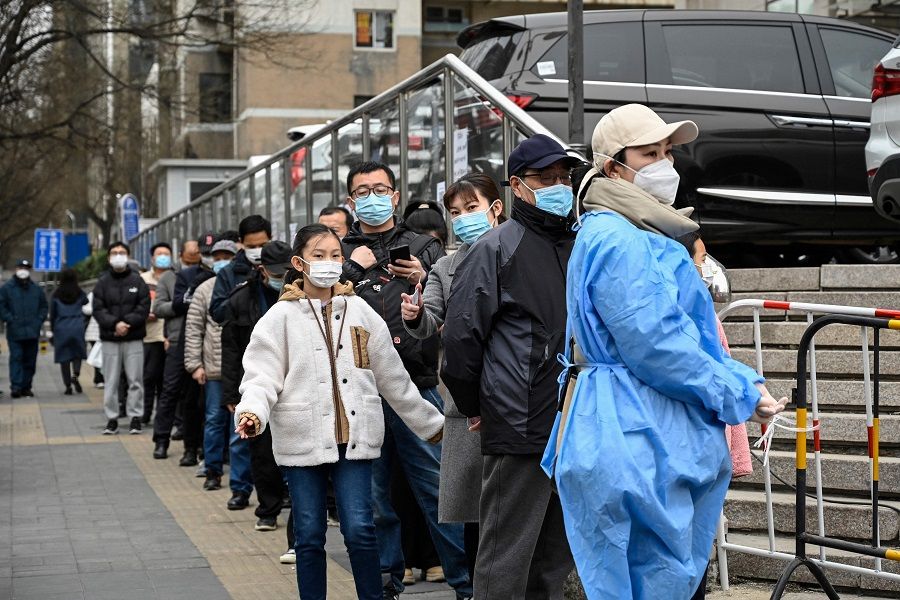China gears up for grimmer economic outlook

(By Caixin journalists Yu Hairong and Zhang Yukun)
China's efforts to stabilise economic growth are running into new speed bumps, upsetting an already fragile recovery.
The current wave of Covid-19 outbreaks - the worst since early 2020 - has infected more than 50,000 people across the country, and measures to contain the spread of the virus have led to city lockdowns, halted some factory production and squeezed the tourism and catering industries. The impact on China's GDP growth in the first quarter could be a loss of 0.3 to 0.8 percentage points, some analysts say.
The upbeat economic data for the first two months of 2022 are also no cause to celebrate, as many analysts say the outlook is grimmer than it looks, and that economic activity could slow in March.
In the national legislative meeting earlier this month, China announced that it expects to grow its GDP this year at "around 5.5%", a goal that many economists say is challenging. The world's second largest economy is grappling with what policymakers have been calling the "triple pressures" of shrinking demand, disrupted supply and weakening expectations, and they have been emphasising the need to stabilise economic growth.
All eyes are on the central government to see what its next move is to shore up growth.
16 million new urban job seekers in 2022
China's economy appears to have gotten off to a strong start in 2022. The January-February data released by the National Bureau of Statistics presents a promising picture of recovery after the nation's GDP growth slowed to 4% year-on-year in the fourth quarter of 2021.
Beijing also promised more tax cuts for businesses, put off plans to expand a pilot property tax programme, and is gradually easing restrictions on the property market.

Despite the strong January-February data, "China is set to see a sharp slowdown in March" because of the most recent Covid-19 outbreaks and China's adherence to the zero-Covid principle, economists at Macquarie Capital Ltd. said in a note published earlier this month.
Weak demand still plagues consumer spending, and the impact of Covid-19 on the services sector remains an impediment, experts said in an economic meeting on 14 March.
Besides the Covid-19 outbreaks at home and surging commodity prices triggered by the war in Ukraine, the slump in the property sector, a driver of China's economy, is also weighing on growth.
China is bracing for as many as 16 million new urban job seekers in 2022, the highest in years, Chinese Premier Li Keqiang said during a press conference after the conclusion of the "Two Sessions". The policy tightening of industries such as private tutoring and internet platforms has impacted some companies' ability to hire, some analysts say. Stabilising economic growth will be key to creating enough jobs to meet such demand.
To shore up economic development, China has been rolling out new policies and measures. In the first few months of 2022, local governments accelerated the issuance of special-purpose bonds (SPBs), a major funding source for infrastructure investment. Beijing also promised more tax cuts for businesses, put off plans to expand a pilot property tax programme, and is gradually easing restrictions on the property market. Meanwhile, policymakers launched support measures for various industries including the services sector to cushion the impact of the pandemic.
... tax refunds and cuts totalling a record 2.5 trillion RMB this year are expected to alleviate the financial strain on businesses...
Support for and pressures on businesses
At a meeting chaired by Premier Li on 21 March, the State Council, China's cabinet, vowed to hand out almost 1 trillion RMB (US$157.1 billion) in tax refunds to small and micro enterprises and individual business owners. An additional 1.2 trillion RMB in transfer payments will be allocated to local governments to support their efforts to implement tax refunds and tax and fee cuts, as well as ensure employment, according to the meeting.

For years, tax and fee cuts have been part of China's toolkit for supporting companies. From 2016 to 2021, China reduced tax and fee burdens by an estimated 8.6 trillion RMB, Vice Finance Minister Xu Hongcai said at a press briefing last month.
According to the annual government work report that Premier Li delivered to the top legislature earlier this month, tax refunds and cuts totalling a record 2.5 trillion RMB this year are expected to alleviate the financial strain on businesses - in particular small- and medium-sized enterprises and sectors including manufacturing, research and technical services, environmental protection, power and gas, and transportation.
A survey on companies' production costs by the Chinese Academy of Fiscal Sciences, a government-backed think tank, shows that despite tax and fee cuts, most businesses still had to wrestle with high costs in 2021. The pandemic and other sources of uncertainty could add to their production costs, according to the survey report published in February.
"The key is to stabilise the expectations of businesses so they don't lose hope," a source with ties to policymakers told Caixin in February. Compared with short-term policy support during an economic slowdown, it's more important to ease companies' concerns through concrete actions such as reforms, he said. He also said that it's important to provide companies with a transition period to make it easier for them to adapt to new regulatory policies.
Over the past two years, China has issued a slew of measures to tighten regulation of the internet, tutoring and real estate sectors as well as overseas IPOs, putting pressure on relevant companies.

Whether China will ease its zero-Covid policy is another factor that could profoundly impact businesses. From 1 March to 24 March, more than 50,000 people across 28 out of mainland China's 31 provincial-level regions have been infected in the recent wave of Covid-19, which escalated rapidly in recent weeks.
China has moved to fine-tune its Covid-19 control policies so they take less of a toll on the economy.
Some cities have adopted strict measures to stamp out the virus. Shenzhen, the southern manufacturing hub, locked down residential communities and industrial parks and suspended public transportation for a week. Shanghai also entered into a two-phase lockdown earlier this week.
The outbreaks are affecting construction and cargo transportation, as well as the services sector, some analysts say.
The impact of Covid-19 on China's first-quarter GDP growth could be a loss of 0.3 to 0.7 percentage points, analysts from China International Capital Corp. Ltd. (CICC) said in a 20 March research note. A Hua Chuang Securities Co. Ltd. report predicted a bigger loss of 0.8 percentage points.
China has moved to fine-tune its Covid-19 control policies so they take less of a toll on the economy. Earlier this month, the National Health Commission revised its Covid-19 response protocol with major changes to diagnostic criteria, treatment and quarantine requirements. The revision was made to address rising Omicron outbreaks and indicates a step toward more-relaxed controls, experts say.
At a 17 March meeting, President Xi Jinping called for better measures to maximise effectiveness in controlling the outbreak at the lowest cost while minimising the impact on society and the economy.
Stablising businesses to maintain employment
Although China's GDP growth target for 2022 is lower than last year's goal of "above 6%", it increased a target for employment. The aim is to keep the surveyed urban unemployment rate under 5.5%. That's more ambitious than last year's target of "around 5.5%". This year's government work report highlights the goal of stabilising businesses in order to maintain employment.
Around 10.8 million fresh college graduates... will be seeking jobs in 2022, and transforming them into labour force will be an important priority for policymakers. - Zhong Zhengsheng, Chief Economist at Ping An Securities Co. Ltd.

Around 10.8 million fresh college graduates - 1.7 million more than last year - will be seeking jobs in 2022, and transforming them into labour force will be an important priority for policymakers, Zhong Zhengsheng, chief economist at Ping An Securities Co. Ltd., said in an article published earlier this month. Zhong warned that services, real estate, tutoring and the internet - among other parts of the economy - may become weaker in creating jobs because of the pandemic and regulatory tightening.
In this year's work report, the government vows to broaden channels for employment, stabilise market entities and let start-ups play a strong role in improving job growth. It also says that policies will be weighted more heavily toward helping companies in the retail, tourism, transportation, catering and hospitality industries, which have a large capacity for employment.
Government investment in infrastructure
For 2022, the central government earmarked 3.65 trillion RMB in SPBs, which chiefly fund infrastructure projects, the same as last year. Combined with leftover money raised from SPBs last year, the actual funds available from these bonds could be larger than that figure, economists say. Profits handed over by state-owned institutions, such as the central bank's 1 trillion RMB, to the country's finance ministry will also contribute to the funds transferred to local governments. With fuller coffers, local governments will be more at ease with funding infrastructure investment.
The government called on cities to make "proactive investments" in infrastructures such as transportation, energy, urban gas pipelines and major water conservancy projects.
The central government has been front-loading this year's SPB quotas to boost local infrastructure spending, but some analysts say it's too early to tell how much the move will drive growth.

Wang Tao, head of China economic research at UBS Investment Bank AG, estimates that growth in infrastructure investment this year could reach 5% to 6%, a leap from last year's flat growth rate.
The central government has been front-loading this year's SPB quotas to boost local infrastructure spending, but some analysts say it's too early to tell how much the move will drive growth.
A CICC survey of construction material companies shows that there hadn't been a pronounced increase in infrastructure demand, and that it may take time for policies and funding to take effect.
Property market gets a bone
China's property market boomed in the first half of 2021 before falling into a slump, as regulatory curbs on borrowing left developers struggling to pay back their debts. The market outlook is still uncertain in 2022. In February, a key indicator of home mortgages declined for the first time in at least 15 years, and sales of the top 100 property developers almost halved year-on-year. At a March press conference, a top banking regulator said the trend toward a real estate bubble had essentially been reversed, and that the government doesn't want to see any drastic adjustments that could damage the economy.
On 16 March, in a move that was seen as a way to stabilise investor expectations, China announced that it would postpone an expansion of the pilot property tax programme this year.

The government work report says the country would move towards stabilising land and housing prices along with market expectations. Policymakers are also committed to accelerating the development of the long-term rental market and the construction of affordable housing, according to the report. It emphasises that city-specific policies are needed to ensure long-term stable development. Previous curbs are being eased, and changes in housing policies have been taking place at the local level.
On 16 March, in a move that was seen as a way to stabilise investor expectations, China announced that it would postpone an expansion of the pilot property tax programme this year. The planned reform could burden local property markets and add to liquidity pressure on developers. Several regulatory departments have vowed to defuse risks in the property sector or support the industry.
This is overall credit positive for rated property developers, although default risks will remain because it will take time for policies to take effect and improve market sentiment, Moody's Investors Service Inc. said in a March report.
(Ma Chengyao, Fan Qianchan and Cheng Siwei contributed to this report.)
This article was first published by Caixin Global as "In Depth: China's Battle to Stabilize Its Economy". Caixin Global is one of the most respected sources of macroeconomic, financial and business news and information about China.
Related: The growing difficulty of balancing China's local government budgets | Stability and growth: Two Sessions' government work report spells out what China wants | China's 2022 economic growth will start low and end high | China to prioritise economic stability ahead of CCP 20th Party Congress | China's local governments going bankrupt?
